
A fume hood can effectively contain dangerous substances while also providing some protection from splashes and slight over pressurizations when utilized appropriately. The standard fume hood has certain limitations even when used as intended.
Limitations
Explosions: Even with the sash completely closed, the Laboratory Fume Hoods are unable to contain explosives. An anchored barrier, shield, or enclosure that is strong enough to deflect or confine an explosive threat must be provided by the user.
Projectiles: Unless the sash is completely closed, a fume hood is not intended to contain high velocity emissions of particle pollutants.
Pressurized systems: Pressurized system leaks of gases or vapors may have enough speed to outpace the capture velocity and escape from the fume hood.
Spill Containment Lips: Modern fume hoods typically include sunken work tables or spill containment lips to help catch tiny liquid spills. These lips frequently have a breadth of several inches. You shouldn’t place liquid containers on the hood’s lip.
Tubing for Exhaust: Exhaust from equipment that is far away is usually directed to the hood using tubing. This is ineffective as a means of control.
Microorganisms: Instead of using a chemical fume hood, work containing dangerous microorganisms should be done in a biosafety cabinet. For further details, consult the Biosafety Manual.
Waste Disposal: It’s not a good idea to dispose of rubbish in a fume hood. Allowing volatile waste to purposefully evaporate and escape up the hood stack is against the law. The hood is not a pollution-control mechanism, as previously stated.
Common Mistakes
Hoods Actively in Use for Experimentation
Materials should be stored as little as possible or never at all. Containment may suffer from materials kept in the hood. Additionally, the hood is typically the scene of the riskiest actions carried out in the lab.
The Fume Hood as a Storage Device
During chemical manipulations, fume hoods are particularly made to provide ventilation for the safety of lab users. They generate far more airflow than is required to store closed containers of even the most dangerous volatile chemicals. This type of material storage is a waste of an expensive piece of equipment.
Hoods Not in Active Use
If adequately segregated and the hood is marked to forbid experimentation, materials that need vented storage (such as volatile and extremely hazardous, or odorous compounds) may be kept there.
It is forbidden to make modifications or additions to an existing fume hood without the express consent of the department’s facilities manager or special facilities supervisor. If devices are added to even the most basic exhaust system without proper inspection and modification, the present hood’s performance will often decline and/or the extra device’s performance will be insufficient.
If you’re planning to buy lab equipment like Laboratory Fume Hoods and more, then connect with IGene Labserve by visiting https://www.igenels.com/ or call 09310696848 to know more.
